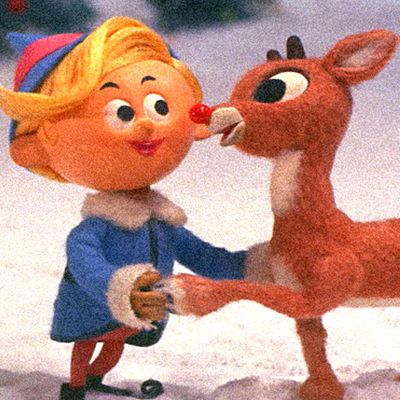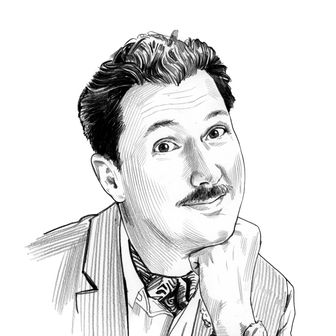
Thinking back on the children’s Christmas specials of yore with an adult frame of reference can be a little bit dizzying. There is the suffocating consumerist melancholy of A Charlie Brown Christmas, the existential dread of a magical friend’s impending death in Frosty the Snowman, and the political allegory of Heat Miser’s rise to power that is A Year Without a Santa Clause.
But nothing, absolutely nothing, is changed with a close, analytical reading of Rudolph the Red-Nosed Reindeer, the 1964 stop-motion special. I mean, just look at it: Rudolph is totally, absolutely, 100 percent, Neil-Patrick-Harris-French-kissing-Ricky-Martin gay. Anyone who even knows what Queer Theory is can tell you that the subtext of the narrative seems to be a pre-Stonewall contemplation of the power of coming out and embracing sexual minorities into society at large.
The film starts in the North Pole, where traditional gender roles are quickly reinforced. Mrs. Claus does all the cooking and nags her husband about not eating enough. The elves, identical in shape and apparel, are at work on Santa’s toys, the boys wearing blue and the girls wearing pink. Rudolph is born to Donner, who immediately hates his son’s red nose and thinks that something so different will keep him from leading a heterosexual life where he pulls Santa’s sleigh and marries a nice doe someday.
Rudolph goes along with his parents’ wishes and wears a black cap on his nose when he goes out to meet the rest of the reindeer for the first time. His father doesn’t care how uncomfortable it makes him — he is going to play reindeer games with the other boys just like he’s supposed to.
“For a year the Donner family did a good job hiding Rudolph’s — non-conformity,” the narrator tells us, pausing slightly before landing on the right euphemism. This is the closet of Rudolph’s parents devising, which he goes along with thanks to the internalized homophobia that he inherited from both his father and Santa, the superego of the North Pole, who is equally distressed by Rudolph’s difference. Santa even goes so far as to tell Donner that he should be ashamed of his son and try to change him. It’s almost as if Santa is a church elder trying to force Rudolph into conversion therapy.
Rudolph can’t take it anymore and heads off into the wilderness to live alone. There he runs into Hermey — the only elf with any hair, and it’s a flamboyant blond wave. He also has especially red lips, a feminine-shaped face, and eyelashes any doll in Santa’s workshop would be jealous of. He speaks with a Paul Lynde cadence, as if his ascot is tied on a little too tight. He’s also signaled as different by his professional aspirations: He wants to be a dentist rather than a toy maker. It’s not that dentistry is especially queer or even the sort of creative job one would expect an open homosexual to have during the Johnson administration, but it hammers home that something sets Hermey apart from his conformist class.
Unlike Rudolph, Hermey refuses to live in the closet, so he leaves Santa’s workshop and heads to the wilderness himself to open up his own dental practice. The woods the two explore could be equated to a traditional cruising ground, like the Rambles in Central Park or Hampstead Heath in London, both notorious for the availability of anonymous male-on-male sexual encounters. When Hermey and Rudolph run into each other, they reprise their song about being misfits, singing, “seems to us kind of silly that we don’t fit in.” Now that these two young gay men have met each other, they realize that the oppression of sexual conformity they’ve been living under their whole lives is a total sham.
That sham is once again underscored when Yukon Cornelius enters those same woods. When he meets Rudolph and Hermey, they are both literally facedown in the snow with their asses in the air. Cornelius is what we would now call a bear, an older, hirsute gay man who embraces an over-the-top masculinity, despite being gay. Cornelius is the original “lumbersexual,” so much so that it’s shocking he’s not wearing a buffalo plaid flannel shirt and a pair of excessively wide braces along with his traditionally macho workman’s wear.
The three of them head to the Island of Misfit Toys. The first person they meet is Charlie-in-the-Box, the official sentry of the Island. If Hermey sounds like Paul Lynde, then Charlie sounds like Paul Lynde doing a Charles Nelson Reilly at Liza Minnelli’s bachelorette party. As the official sentry, he welcomes these three like-minded gentlemen into a land where all people of difference are accepted and can flourish. We know it’s a land of otherness because when Rudolph, Hermey, and Cornelius spend the night, they sleep in a pink room with pink sheets and blankets, coded traditionally female. This is the gay community that all of these men find after leaving the closet behind. This is the family of their own making that they devise because their own biological families have rejected them.
The problem with the Island of Misfit Toys is that they all long for the acceptance and embrace of society at large. The leader of the Misfits, King Moonracer, tells Rudolph to go back to Santa and convince him that toys like the Misfits are worthy of acceptance and inclusion as well. But Rudolph takes off in the middle of the night, still afraid that his very obvious red nose will bring the wrath of the Abominable Snow Monster, a fanged embodiment of violent homophobia.
Rudolph returns to the woods and, as the narrator says, “Rudolph would make a friend or two, but it wouldn’t last long.” (Translation: Rudolph is promiscuous and engaging in the sort of short-term relationships that gay men were expected to have at the time.) Eventually, Rudolph learns that the homophobia that was coming for him now threatens his parents and friends. He rushes to save his parents, but is knocked out by the untamable Snow Monster. Hermey and Cornelius swoop in to save them, with Hermey literally defanging the beast. They are essential in this confrontation: The two prove to Santa, Donner, and the rest of the patriarchy that gay men can be useful to them, and just as masculine as anyone else.
This renders the Snow Monster docile, tamable. He is welcomed into the society of the North Pole just as the rest of the former outcasts are, after they prove their worth. Their difference hasn’t been extinguished, but straight people now know that the thing that makes Rudolph so rare is also the thing that can save Christmas. It’s almost as if he is their own Carson Kressley, someone who is allowed to be as flamboyant as he wants as long as he isn’t a threat to their way of life — his gayness can even help transform them into something even more worthwhile.
The biggest counterpoint to this reading is that Rudolph has a love interest: the shockingly underdeveloped Clarice, who will go on to become an FBI agent who solves the string of Buffalo Bill murders. Just kidding, she doesn’t do that. But Rudolph doesn’t seem to willingly enter a relationship with Clarice and only starts to speak to her because the other boys urge him to. She represents the desires he is expected to have. This being the early ’60s, the film’s subtext also needs to lie fully below the surface — Rudolph can’t be entirely gay. Once he proves he is macho enough for the sleigh, he is given a suitable reward: a woman to marry and breed with under the auspices of matrimony.
Cornelius and Hermey aren’t given similar whitewashings. Hermey is allowed to become a dentist and remains unattached. Cornelius, always the most passable of the bunch, gets to stay in the North Pole since his masculinity seems to have ushered in a “live and let live,” or at least a “don’t ask, don’t tell” chapter into the culture. Santa, as superego, has warmed to those who express their sexual differences — the homophobia that fueled their fear has been rendered harmless (though still present), and those who were formerly shunned because of their flamboyant differences have been embraced. Rudolph is the parable of gay acceptance that many of us always wanted and some of us didn’t know we already had.


